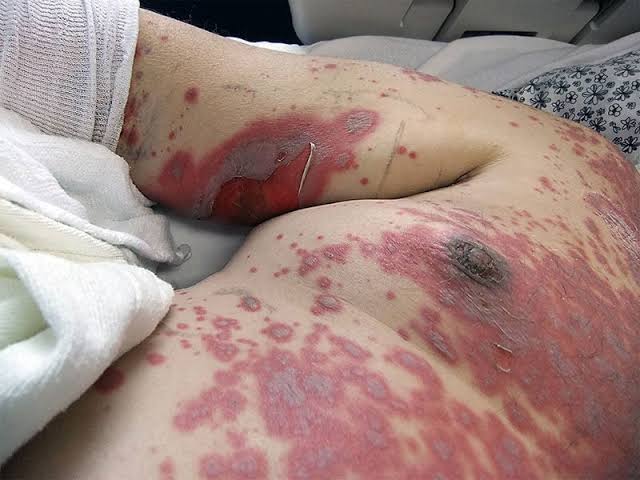Rhinophyma;

Overview:
Rhinophyma is a skin condition that primarily affects the nose, resulting in its enlargement and distortion. This article will delve into the causes, symptoms, and treatment options for this condition.
What is Rhinophyma?
Rhinophyma is a subtype of rosacea, a chronic inflammatory skin disorder. It typically occurs in individuals with severe and longstanding rosacea, although the exact cause is still not fully understood. The condition is more common in men than in women and usually develops in adulthood.
Causes of Rhinophyma:
- Genetic Predisposition: Some individuals may have a genetic predisposition to developing rhinophyma, as it tends to run in families.
- Chronic Rosacea: Rhinophyma often occurs as a complication of untreated or poorly managed rosacea. Rosacea is characterized by facial redness, flushing, and visible blood vessels, which can eventually lead to rhinophyma if left untreated.
- Sebaceous Gland Hyperplasia: There is evidence to suggest that an overgrowth of sebaceous glands in the nose may contribute to the development.
Signs & Symptoms:
- Nasal Enlargement: The most noticeable symptom of rhinophyma is the progressive enlargement and distortion of the nose. The nose may become bulbous, irregular in shape, and develop prominent pores.
- Thickened Skin: Affected areas of the nose may develop thickened, bumpy skin with a rough texture.
- Redness and Swelling: Rhinophyma can cause persistent redness and swelling of the nose, which may worsen over time.
- Ocular Symptoms: In some cases, it may be associated with ocular symptoms such as dryness, irritation, and inflammation of the eyes.
Risk Factors:
Several factors may increase the risk of developing rhinophyma:
- Gender: Men are more likely than women to develop it.
- Age: Rhinophyma typically develops in adulthood, with the risk increasing with age.
- Family History: Individuals with a family history of rhinophyma or rosacea may have an increased risk of developing the condition.
- Untreated Rosacea: Chronic and untreated rosacea is a significant risk factor for the development of rhinophyma. Failure to manage rosacea symptoms effectively can lead to the progression of the condition.
- Sun Exposure: Prolonged exposure to ultraviolet (UV) radiation from the sun can exacerbate rosacea symptoms and increase the risk of developing rhinophyma.
- Alcohol Consumption: Excessive alcohol consumption has been associated with an increased risk of developing rosacea, which can subsequently lead to rhinophyma.
- Smoking: Cigarette smoking has been linked to the development and worsening of rosacea symptoms, including rhinophyma.
Treatment of Rhinophyma:
Here are the treatment modalities commonly used:
1. Medical Therapy:
Medical therapy focuses on managing the underlying rosacea symptoms that contribute to the development of rhinophyma. This may include:
- Topical Medications: Prescription topical medications such as metronidazole or azelaic acid can help reduce inflammation and control flushing associated with rosacea.
- Oral Medications: Oral antibiotics, such as doxycycline or isotretinoin, may be prescribed to reduce inflammation and prevent bacterial overgrowth on the skin.
- Steroid Creams: Topical corticosteroid creams may be used to temporarily reduce redness and inflammation, although prolonged use should be avoided due to the risk of skin thinning.
2. Laser Therapy:
Laser treatments are commonly used to improve the appearance of rhinophyma by reducing excess tissue and smoothing out the skin’s surface. Options include:
- Carbon Dioxide (CO2) Laser Resurfacing: This ablative laser treatment removes layers of skin, promoting collagen production and tightening the skin.
- Intense Pulsed Light (IPL) Therapy: IPL therapy targets blood vessels and pigment in the skin, reducing redness and improving overall skin texture.
- Fractional Laser Therapy: Fractional lasers create tiny wounds in the skin, stimulating collagen remodeling and promoting smoother, more even skin.
3. Surgical Resection:
In more severe cases of rhinophyma, surgical intervention may be necessary to remove excess tissue and reshape the nose. Surgical techniques may include:
- Scalpel Excision: The surgeon uses a scalpel to carefully remove excess tissue and reshape the nose.
- Electrosurgery: Electrosurgical techniques use high-frequency electrical currents to precisely remove tissue while minimizing bleeding.
- Cryosurgery: Cryosurgery involves freezing and destroying abnormal tissue using liquid nitrogen.
4. Maintenance Therapy:
Following treatment, it is important for individuals with rhinophyma to maintain a consistent skincare routine and adhere to any prescribed medications to prevent recurrence and manage rosacea symptoms. This may include:
- Gentle Cleansing: Using mild, non-abrasive cleansers to cleanse the skin and remove impurities without causing irritation.

CeraVe Face Wash Acne Treatment | Salicylic Acid Cleanser

La Roche-Posay Effaclar Purifying Foaming Gel Cleanser
- Sun Protection: Applying broad-spectrum sunscreen with a high SPF daily to protect the skin from UV radiation and prevent worsening of rosacea symptoms.
- Moisturization: Using moisturizers to keep the skin hydrated and prevent dryness, which can exacerbate rosacea symptoms.
Overall, the treatment approach for rhinophyma should be tailored to the individual’s specific symptoms and severity of the condition. A combination of medical therapy, laser treatments, surgical resection, and maintenance therapy can help improve the appearance of the nose and manage associated symptoms effectively.
Prevention of Rhinophyma:
While rhinophyma may not always be preventable, there are steps individuals can take to reduce their risk of developing this condition, especially if they have rosacea or a family history of the condition. Here are some preventive measures:
1. Early Detection and Treatment of Rosacea:
- Regular Skin Examinations: Be vigilant about changes in skin texture, appearance, and sensitivity, especially on the face.
- Prompt Treatment: Seek medical attention if you notice symptoms of rosacea, such as facial redness, flushing, visible blood vessels, or acne-like bumps. Early diagnosis and treatment can help prevent the progression to rhinophyma.
2. Lifestyle Modifications:
- Sun Protection: Protect your skin from excessive sun exposure by wearing broad-spectrum sunscreen with a high SPF, seeking shade, and wearing protective clothing, such as hats and sunglasses.
- Limit Alcohol Consumption: Excessive alcohol consumption can exacerbate rosacea symptoms and increase the risk of developing rhinophyma. Limit alcohol intake or avoid it altogether if you have rosacea.
3. Skin Care:
- Gentle Cleansing: Use mild, non-abrasive cleansers to cleanse the skin and remove impurities without causing irritation or exacerbating rosacea symptoms.
- Avoid Harsh Products: Avoid skincare products containing alcohol, fragrances, or other potential irritants that can aggravate sensitive skin.
4. Stress Management:
- Stress Reduction Techniques: Practice stress-reduction techniques such as meditation, deep breathing exercises, yoga, or mindfulness to help manage stress, which can trigger rosacea flares.
By adopting these preventive measures, individuals with rosacea can minimize their risk of developing rhinophyma and maintain healthier skin overall.
• Read more:

